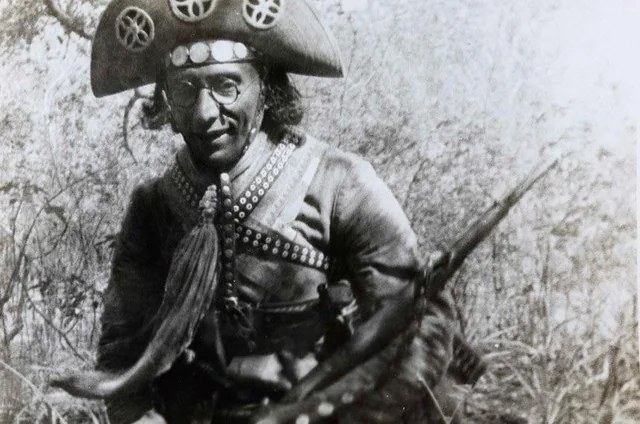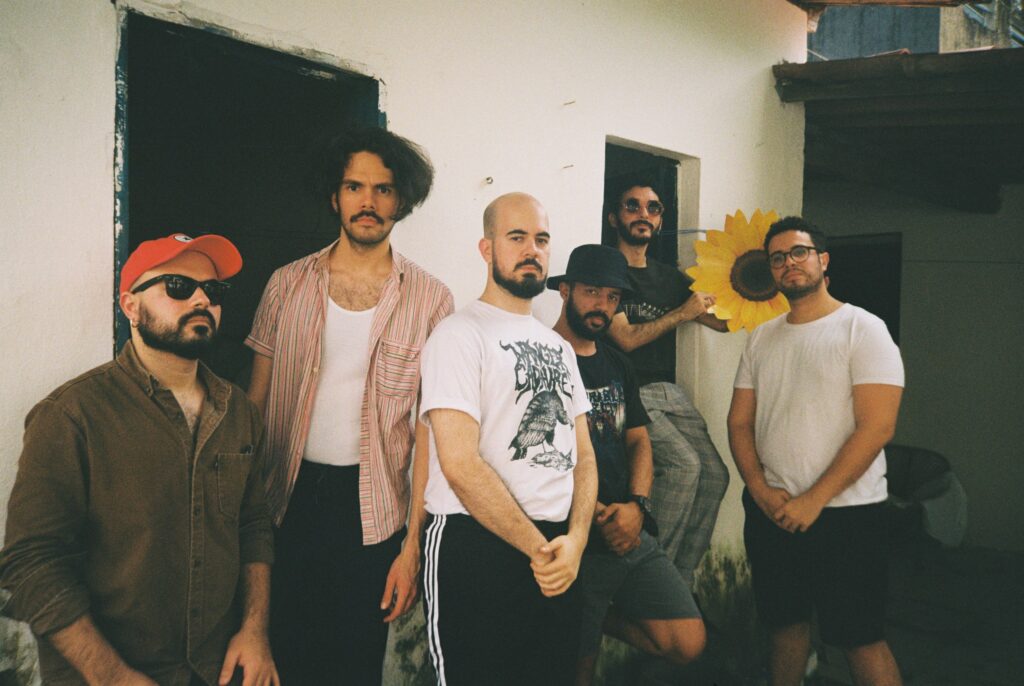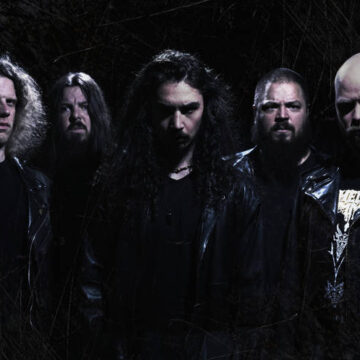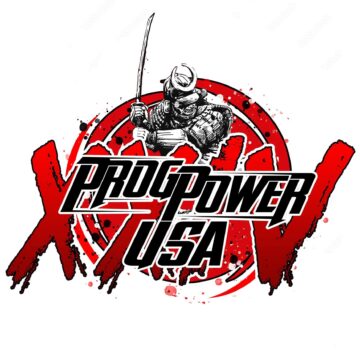Interview: Papangu
My, oh my, another week, another interview. It’s almost like we’re becoming an actual publishing outlet! Today we’re chatting with Papangu, who took the progressive scene by storm in 2021 with their zeuhl-infused sludge metal debut Holoceno. Their follow-up Lampião Rei is set to release on September 6th, marking a whole new direction for the band. We sat down with Marco, Pedro, Hector, and Rodolfo to talk about the new album, how their nation’s music has influenced their evolution, the mythical figure who inspired the album, and much more!

Q: Hello, Papangu, long time no see! It’s an important time for you guys as you’re now releasing your sophomore album after such an explosive debut! I know there are so many people excited to hear Lampião Rei, and I’m lucky enough to have given it a few spins already and ask you the questions the world needs to hear. How have you all been since we last spoke?
Hector: Pretty busy! We’ve been touring, rehearsing and composing a lot. Since Holoceno was released we’ve toured Brazil twice – got ourselves into some cool gigs, including festivals. Also worth mentioning the upcoming (October 20th) Knotfest Brasil gig, which will be our first time playing in a stadium. We managed to write some songs for future stuff and other projects that we cannot disclose right now. So pretty busy overall, I’d say. We’re having a blast. We’re all very happy with everything that has happened since Holoceno debuted but we’re also very confident and very proud of Lampião Rei. Cannot wait for everyone to hear it.
Marco: Working our asses off, both in the band and in our own professional/academic lives! So far, it’s been paying off. We’ve grown a lot as a band, too, and learned so much from touring Brazil and recording Lampião Rei.
Q: Having given Lampião Rei a few listens now, it’s evident you upped the zeuhlishness compared to Holoceno, both the prog rock and jazz influences are on wide display. With the changes in style on this album, were there any particular bands who influenced the musical direction you took for Lampião Rei?
Hector: I don’t think that any particular band or artist influenced the musical direction but rather our own collective and conscious decision to create a different work of art. Some of the very first talks me and Marco had about the sophomore album were around the topic of moving the band forward, musically speaking. We know that Holoceno brought the band from nothing to where we are today, but we just couldn’t write the same record again. It wouldn’t be honest or genuine, and that’s my favorite kind of music: the kind of which the listener can actually feel that the music represents what the artist wanted to do. Having said that, I was listening to Cátia de França a lot when we were writing the first pieces. I remember Marco was very much into Edu Lobo.
Marco: I think the musical influences here are much more subtle than what we channeled in Holoceno. If the album sounds more like zeuhl and prog rock it’s just because we’ve gotten confident playing challenging parts live together. A good reason why old Yes and Magma records sound like that is because they were doing things live in the same room, and we wanted to channel that method of classic bands, rather than try to mimic their riffs, patterns, or song structures. Lampião Rei really is how we sounded playing together in that studio, rather than the DIY bedroom wall-of-sound approach to metal that permeated Holoceno’s production. For example, instead of DI guitars and bass through Joyo pedals straight into a cheap audio interface, here you can hear us playing real tube amps through actual speakers through good microphones into great preamps. A proper studio album, with few takes and no bullshitting, so we were really trying to do a record like it was done in the old days without messing up the real sound we got in the studio rooms.
Rodolfo: I reckon I was more influenced by textures, timbres, and instruments rather than harmonies, melodies, or rhythms. I was indeed influenced by Papangu itself. Having played dozens of gigs with my brothers between late 2022 and mid 2024, I truly welcomed the chance to play metal and prog again, having spent years in the jazz and blues scene. It’s definitely a two-way road.
Q: A couple of us at the blog are huge fans of Brazilian folk music, so we’re excited to hear all the forró, maracatu, and samba influences shine through even brighter. Clearly you guys have a huge passion for your regional scene. There are torchbearers like Angra and Sepultura, of course, and other contemporaries like blog-favorite Kaatayra, but Papangu feels so natural! How naturally do you find incorporating Brazilian musical influences into metal? Do several of you have extensive backgrounds outside of metal and even prog?
Hector: First of all, so cool to hear you guys dig that kind of stuff! But yeah, it actually feels very natural for us. It’s not something that we try to force or display as a gimmick to our sound, and I think it shows. As I said in the last question, I appreciate genuine and heartfelt music, regardless of genre or style. When it comes to backgrounds outside of rock n roll, the fact that Vitor plays drums for us but also for a thrash/death metal band and also plays zabumba and triangle for a forró trio, it’s a very good example of how we naturally shift between these influences. Rodolfo played keys for years in a forró group. I was raised on both The Beatles and this amazing band called Mestre Ambrósio (countrymen and contemporaries to Nação Zumbi) that features traditional northeastern Brazilian sounds with a modern twist. And when it comes the time to write songs, we just let it all flow in the most natural and beautifully intertwined way we can. It’s music without borders or prejudice.
Rodolfo: We are from the Northeast. It’s nearly impossible to go past May, June, and July without being overwhelmed by the region’s traditional music, namely forró—which is both at the background and foreground of the several festivals and parties taking place around this time. I’ve listened to and played forró nearly all my life. It’s second nature. While I’ve played metal and prog for many years, I also had the chance to tour extensively with a septet that played traditional forró. However, I made a point of using only vintage instruments at the time: Hammond organs, Fender Rhodes, Wurlitzers, and Moog sounds.
Marco: I had a small stint playing electric bass in a student jazz big band and studied double bass very sloppily for five or so years. Anyhow, I listen to very little metal – I’m usually thinking of Brazilian music, jazz-rock records, or classical composers I dig, like Messiaen, Dutilleux, and Ravel whenever I’m composing. Now that we’re better equipped to mess with a broader palette of both instruments and musical language, I think it’s natural that we want to try bringing these influences a little closer into the mix. We’re still gonna keep making loud and heavy music, though.
Q: Also, welcome to the band Vitor, Rodolfo, and Pedro! As the newest members of one of my favorite underground projects, how have you been involved in the creation of the new album? Each of you bring various strengths to the band, and I’m excited to hear about what aspects you guys feel you add to the sound underneath the surface of your awesome performances.
Rodolfo: Keyboards play a significant part in lots of 70s prog music. It seems to me that bringing the keys to the spotlight with a full-time keyboardist definitely highlights a less subtle prog rock influence. Still, I’ve always let those blues licks escape whenever people are not looking, so there’s that. Finally, I’m yet to fathom a world without thunderous, lightspeed lead synth arpeggios. Shame on me. I’m also happy to sing and contribute to vocal harmonies and arrangements throughout Lampião Rei. My contributions have always been welcomed by the founding members—”Maracutaia”’s release is the epitome of this burgeoning relationship.
Pedro: Thank you for welcoming us! It’s very nice to be part of Papangu. I feel both my skills as an arranger as well as a composer were improved during the production and recording of Lampião Rei. I’m used to being part of projects that are jazz-oriented, so my music is mainly in the fields of Brazilian instrumental music. Prog and classic rock music also played a very important role in my life, so having all that melt together within genres I was not as familiar with, such as zeuhl, grindcore, sludge and stoner-rock, was and still is a pretty challenging and wonderful experience!
Q: The concept of the album was inspired by the historical life of Virgulino Ferreira da Silva. Looking into his life, he seemed to be a very morally gray figure, being both a symbol of honor and piety as he was a rampant murderer. I’m curious what drew you all toward Ferreira as a central figure. What is the message of the story you’re trying to tell?
Marco: As far as I know, Lampião has almost always been regarded as this brave mythical entity in Brazilian history. He’s a polarizing figure whose life story isn’t really consistently interpreted for what it is: a sad story of someone shaped by unfair circumstances that derived from consistent oppression and inequality.
For example, there’s a local big-mouth far right politician who was named after Lampião and wears that name on his sleeve, misusing the historical weight behind Virgulino’s circumstances and promoting a pro-police violence message that does well with conservatives. The thing is that Lampião’s father was unlawfully murdered by a police officer when he was a teenager. Lampião was not an angel himself, but he and his crew were summarily executed by police forces in 1938, and their bodies were subjected to the grimmest sort of public humiliation you could imagine. They were decapitated and had their heads exposed on a town square for a week. Later, they were sent off to labs so that phrenologists could draw up outrageous, racist conclusions of how these people – either native Brazilians, descendants of slaves, or multiracial – would be destined to become criminals. That discourse played well to mask the true reason why people went into a life of crime: suffering under heavy and ruthless systems of inequality and injustice.

Adding insult to injury, former Brazilian president [Jair] Bolsonaro also tried to cash in on using the Cangaço movement’s imagery in his favor, posing for photos using traditional cangaceiro headwear, like the sort of stuff Lampião had worn. This whole thing about claiming to be an underdog – when you’re obviously not – and using these symbols to say you’re a brave fucking guy who’s fighting evil against all odds when you’re embodying and supporting illegal state violence also warranted a response from the arts. Now I know indie bands are not a relevant force in politics at all, but the people who listen to our music are likely voters. Better to use our medium to spread a good message than to be a politically aseptic act that’s afraid of polarizing listeners.
But I digress. Our record’s story aims to reject that misinterpretation of Lampião’s life entirely, and attempts to ressignify his “myth” through a different lens. Still distorted, because this is after all a concept album, not a thesis, but we’re using allegories and other storytelling methods to circumvent the “Hell yeah! I’m a goddamn macho!” idea and instead present the tragedy of a people’s response to being left to rot by the state, to being mercilessly and extrajudicially hunted down by the police forces, and to being drained of money and life by the remnants of the slavery system – which I remind you, only officially ended in Brazil in the year 1888, merely ten years before Lampião was born.
Also, there’s a whole gamma of aesthetic elements that drew us to this subject. Lampião and his crew were absolute dandies – actual adepts of dandyism – who designed and tailored their unique flashy garments, sang beautiful songs, loved expensive French cologne, were deeply immersed in Afro-Brazilian religious syncretism, and committed acts of Robin Hood-style robberies to give some money back to poor citizens. They lived a life of spiritual glamor in the unforgiving backlands of one of the most beautiful parts of the world. How can you not want to write a record about that?
There’s a lot more to the story that we’d prefer not to disclose, though. An attentive listener who reads through the lyrics carefully might be able to unravel a lot of things.
Q: You had mentioned previously that a majority of the compositions on Holoceno were taken from years of jam sessions from your original group of friends. Did Lampião Rei go through a similar songwriting process? With the increased jazz-influence, I imagine there is a natural bridge between improvisation and composition in your sound.
Marco: Sort of. I cannot speak for how Rodolfo and Pedro composed their pieces for this record (“Maracutaia” was written by Rodolfo and features one riff I wrote, while both “Sol Raiar” and “Ruínas” were composed by Pedro alone), but I tend to compose by bringing myself to a state of stream of consciousness. Sometimes that happens when I try out ideas on the guitar by myself (“Acende a Luz Pt. III”, “Rito de Coroação”, most of “Oferenda no Alguidar”) or when we sit down together to bounce off riffs and melodies and flesh out the harmony – which is how the first two parts of “Acende a Luz” and most of “Boitatá” came to life.
Rather, improvisation’s role in shaping this record’s sound came naturally from having the band heavily rehearse and play these pieces live, slowly fermenting the base arrangements into something else. Now that we’ve fully transitioned back into being a live band, I think the next Papangu records will benefit a lot more from what we’re learning from playing and improvising together – but Lampião Rei is still somewhat rooted in similar compositional methods to the ones we used for Holoceno. Who knows, it might be a transitional record after all, but it’s one we’re incredibly proud of.
Rodolfo: I tend not to think much about how songs come about. They mostly appear when I’m fiddling with the piano. With regard to arrangements and the increased jazz influence, ideas came during rehearsals alongside the band. We worked a lot on dynamics and ins and outs—what each one is doing while the other has the spotlight. Regarding the interaction between writing and improvising, Lampião Rei has lots of solos, which speaks volumes of our need to vent that creativity. But I’d say most improvisation within the band happens live, when we allow ourselves to shape form and matter for basically every song in the set.
Pedro: Because of my background in jazz and Brazilian instrumental music, I tend to leave room for improvisation in the composition. This is a quality present in the music of Moacir Santos, Egberto Gismonti and Hermeto Pascoal, very inspiring figures that have successfully mixed a diversity of genres within their music. In Ruínas, those influences are very clear, as well as some traces of Frank Zappa and Gentle Giant. Sol Raiar, written in partnership with Marco, has some echoes from Cátia de França’s classic album 20 Palavras Girando Ao Redor do Sol, and Dominguinhos’ Domingo, Menino Dominguinhos. Both records are within the genres and subgenres of forró music (coco, xote, toada), but they feature a lot of the Rhodes keyboard, electric guitars and have a pinch of jazz and/or rock music.

Q: Now that you’ve been around for a few years, I’m sure you’ve made a lot of friends in the music world. Are there any bands from your local scene that you want to recommend or particularly enjoy playing live with? Any from the wider music world?
Marco: I’ve been living in Berlin, Germany for a couple years now, and had the pleasure to meet many musicians I admired and, in some cases, become friends with some of them, including some of the people in Norwegian bands: Sex Magick Wizards, Full Earth, I Like to Sleep, and Kanaan; plus German bands SEK, Weite, and Gaffa Ghandi. You probably know about Italian death metal avant-gardists Ad Nauseam, too, but I double recommend them.
Hector: Make sure to check our hometown friends and weirdos from Tela Azzu, for sure. Also hailing from our hometown, check out the deep beats and nasty grooves from Chico Correa and his awesome project called Berra Boi. Then there’s our friends in Test for some crazy and experimental grindcore. If you want in-your-face-godzilla-rampaging-through-a-city grindcore, give Facada a listen. If you want some Converge-inspired metal/hardcore, here’s Institution. If you like fast, feminist and female-fronted crossover/thrash, here’s Eskröta. They’re all very different bands within different genres of music, but they’re all good friends with us.
Rodolfo: I second my peers’ recommendations, and would just like to add that we’ve collaborated live a few times with a dear friend of ours, the French saxophonist Benoit Crauste. While he’s not from the local scene, his Brazilian influence and dedication to studying and playing Hermeto Pascoal really shows in his songs and live performance. We’ve also had a brilliant feature in our new album, a local performer, songwriter, and icon in the avant garde music from Paraíba, namely Paulo Ró.
Pedro: Shout out to Alamiré, a group from our hometown that mixes african rhythms, jazz, rock and Brazilian music all together in a very authentic way. Also, to another neighbor of ours, Lucas Gaião (singer, composer, guitarist, arranger), a very sensitive artist who reflects a lot of Brazilian-northeastern rhythms in his style of songwriting.
Q: To finish things off, what can we expect from you in the future? Do you have any behind the scenes snippets for our readers?
Marco: We’ve just been welcomed into Atonal Music Agency’s roster, who will be representing us for bookings in Europe and the UK. Needless to say, we’re pretty excited to play our first concerts outside of Brazil! Though our fanbase in Brazil has been growing quite a lot in the past two years, our biggest audience seems to be in Europe and the US, so that should be pretty damn cool, as I truly believe the best way to experience our music is by seeing us play live. The arrangements really come out of the frame and bite you in the face.
We’re also getting back into writing more material for our next recordings, and have a couple of collaborations in the works.
Behind the scenes, I can tell you that Acende a Luz Pt. III, which is probably the most technically demanding piece on Lampião Rei, was recorded without us counting the time signatures. We came up with a mnemonic poem to remember the ever-changing patterns that is essentially a short story about a marmoset smoking a doobie. Being in a band is fun!
Thank you to Papangu for indulging us!
Lampião Rei releases on 6 September 2024.



0 Comments